RIOT:Civil Unrest takes momentous global conflicts and reduces them to a simplistic pixelated tug-of-war, lobbing in a few Molotov cocktails for dramatic effect.
Type: Single-player / Local MP
Genre: Strategy, Simulation
Developer: Leonard Menchiari,
IV Productions
Publisher: Merge Games
Release date: 12 Feb, 2019


RIOT: Civil Unrest places you amidst the haze of tear gas and glare of searchlights as you rally an undisciplined mob towards some ill-defined ideological goal, or adversely, to don riot gear and dive in on the side of police as you subdue the angry, unwashed masses, trusty wooden baton at the ready. Using actual historical uprisings as a backdrop, RIOT attempts to simulate full-on social pandemonium on a miniature scale. But the inelegant interface, unresponsive controls, overbearing visual clutter, limited feedback, terrible instructions, and constricted maps may leave you feeling like you’re playing with your hands zip-tied behind your back.
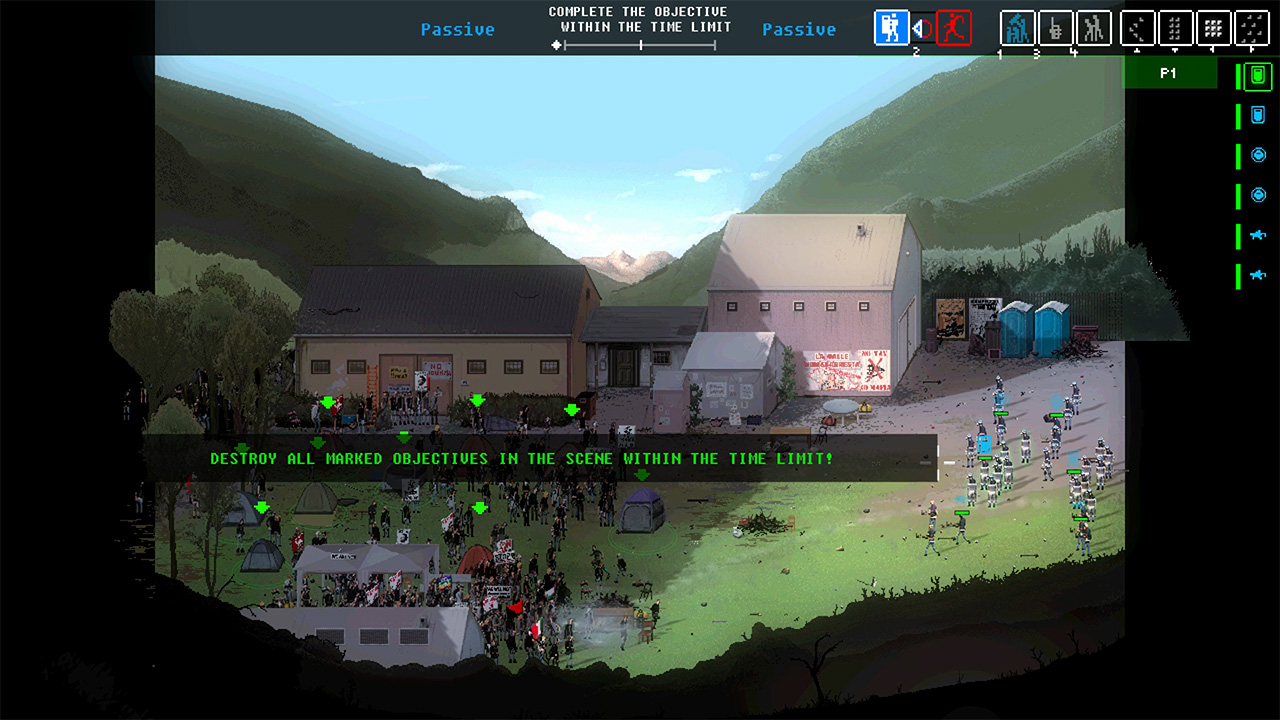
The Fickle Crowd
Typical play attempts to be RTS-like, but without the strong sense of control, tactics, logic, strategy or balance that is usually seen in that genre, making the results feel more like a riot-themed sandbox. There are several campaigns you can choose from, and after you select which side you’ll be playing, you can define the loadout for your hapless lemmings, being careful not to overpower them, because the more gear you outfit your teams with, the stronger the response will be from the other side, and the more precarious public opinion will be. Once the level launches, you’re presented with a timer at the top of the screen instructing you to complete a given goal within the stated limit, such as to hold a position, destroy static targets, protect an area, or disperse your opponent.
You control your ranks by clicking their respective team icons and issuing orders or using one of their equipped items. Commands come with a cool-down period, and you can switch between passive or aggressive actions, with appropriate consequences for each. Victory isn’t always cut-and-dry, and depending on which tactics you follow you will either gain or lose political favor for your cause, which in turn will make the next level easier or harder for your side.
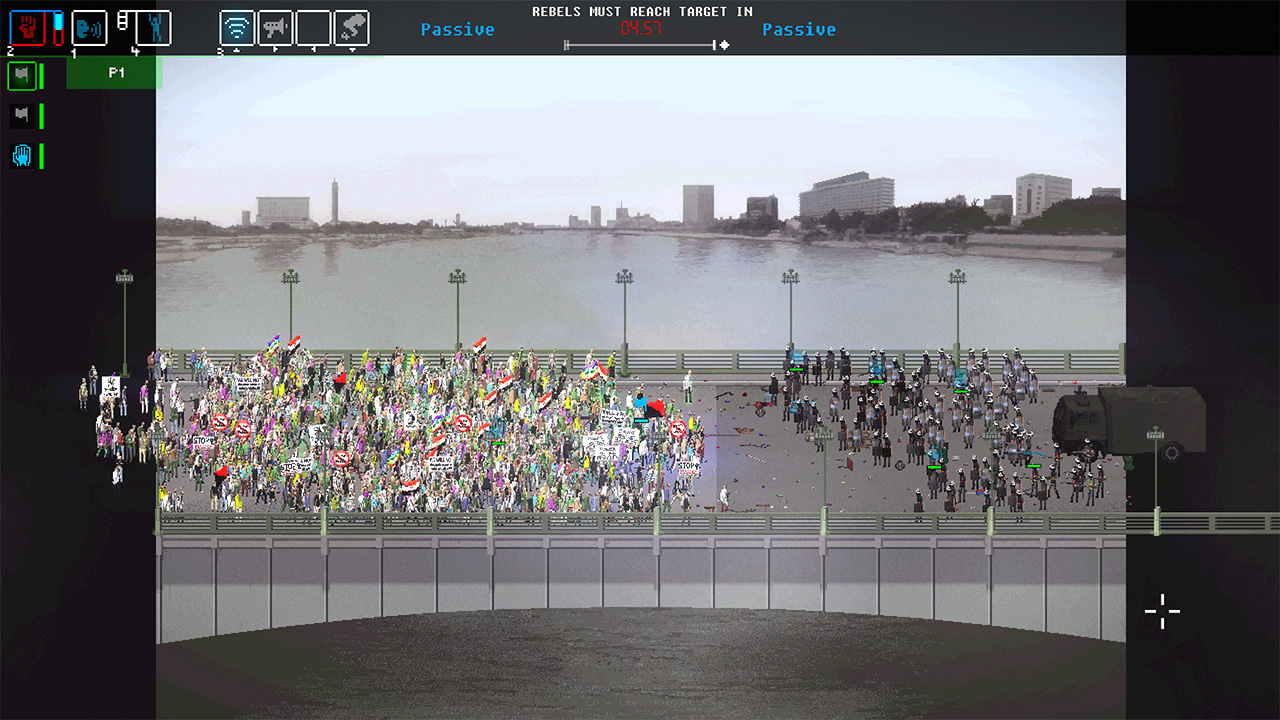
I absolutely adore pixel art, but using it for an RTS like this results in the player battling clutter more than battling their opponent. I think in a lot of ways, the fantastic art of RIOT is a roadblock to its playability, since it simply becomes just too visually noisy too quickly. In other such games, avatars usually represent groups of individuals. This makes them representative graphics that are easier to track and manage on a crowded battlefield. RIOT, by contrast, takes a literal approach, and every single blocky character sprite represents a single individual, and in a game that can have hundreds in a mob, the screen becomes blindingly dense very quickly. The limited size of the topographically-flatlined maps don’t help either, as it forces all of the units into a crowded space, where they’re constantly overlapping and getting lost in the melee. In order to really follow the actions of the parties you control, you have to either squint, or zoom in; but owing to the (otherwise lovely) pixel art, zooming in on the scene renders it even more abstract, and at that point it’s just RGB soup.
Chaos, as an aesthetic theme, does not make for a very playable game. Half the time I couldn’t tell if the orders I issued were being followed or not. Most of the commands require that you click somewhere to tell the agents where to execute their action. But since the game screen is such a crowded mess of pixel-vomit, with dozens upon dozens of sprites flickering on top of each other, it’s unnecessarily difficult to even find a spot to click without inadvertently mousing over something else. I did eventually switch to the (limited) keyboard shortcuts and had better luck issuing commands. Even so, pathfinding was spotty, and more than once characters got stuck off screen among the giant black borders that tend to flank each level. At the best of times, RIOT felt like the video game equivalent of herding cats.
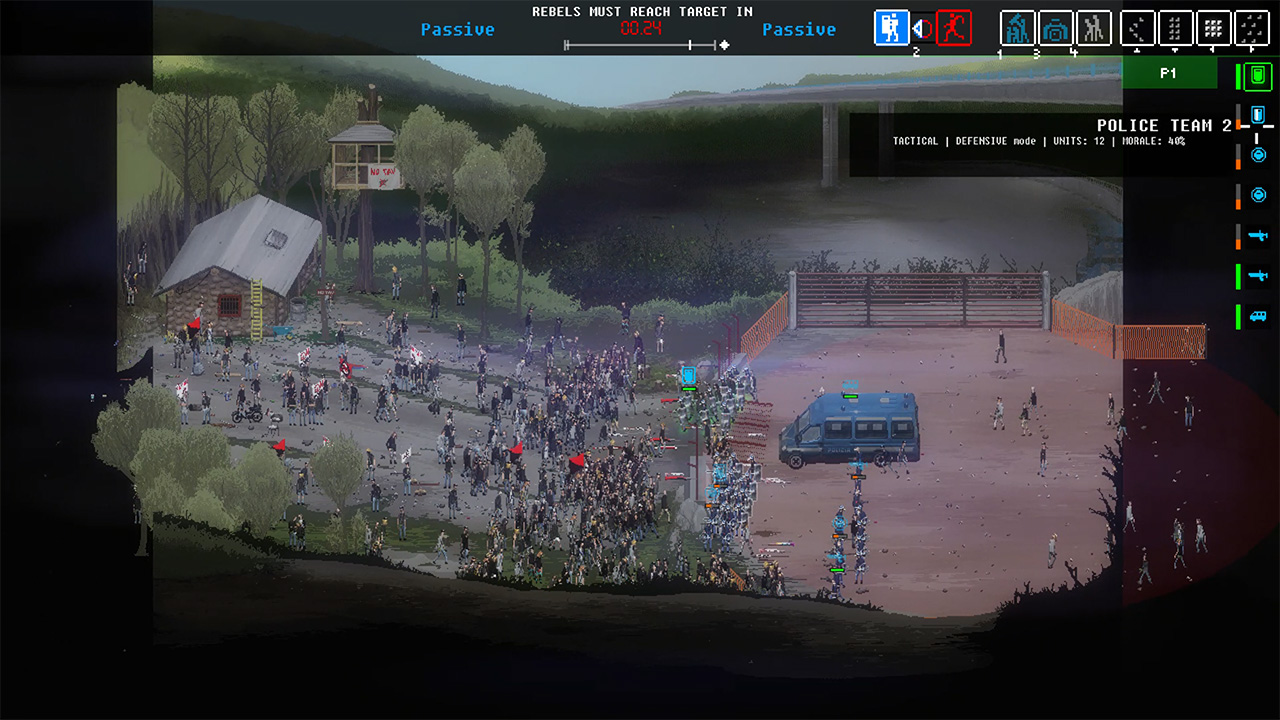
It doesn’t help that there is an overall lack of player feedback throughout the game. A lot of the factors that affect how parties move and execute actions, such as morale, courage, cool-downs, and even where each member is when a group is scattered, are just too hard to read or access among the visual din of overload that the game devolves into. The resulting mess leaves the player more often than not having to guess as to what works, what doesn’t, and why.
Some of this is forgivable in a turn-based game, as you have time to assess the situation and sort through the clutter, but being stuck with an RTS-like system and going into each conflict with such limited feedback leaves the player unexpectedly constrained. Yes, yes, I know…the devs want to impart a sense of chaos to the player; but by being so antagonistic with its controls and feedback, they are manufacturing a false sense of chaos just by making their own game needlessly confusing. I can’t help but wonder if RIOT would’ve turned out better had it been turn-based, or hex-based, or in some other way had an external structure imposed onto it, because by itself chaos is neither fun nor playable.
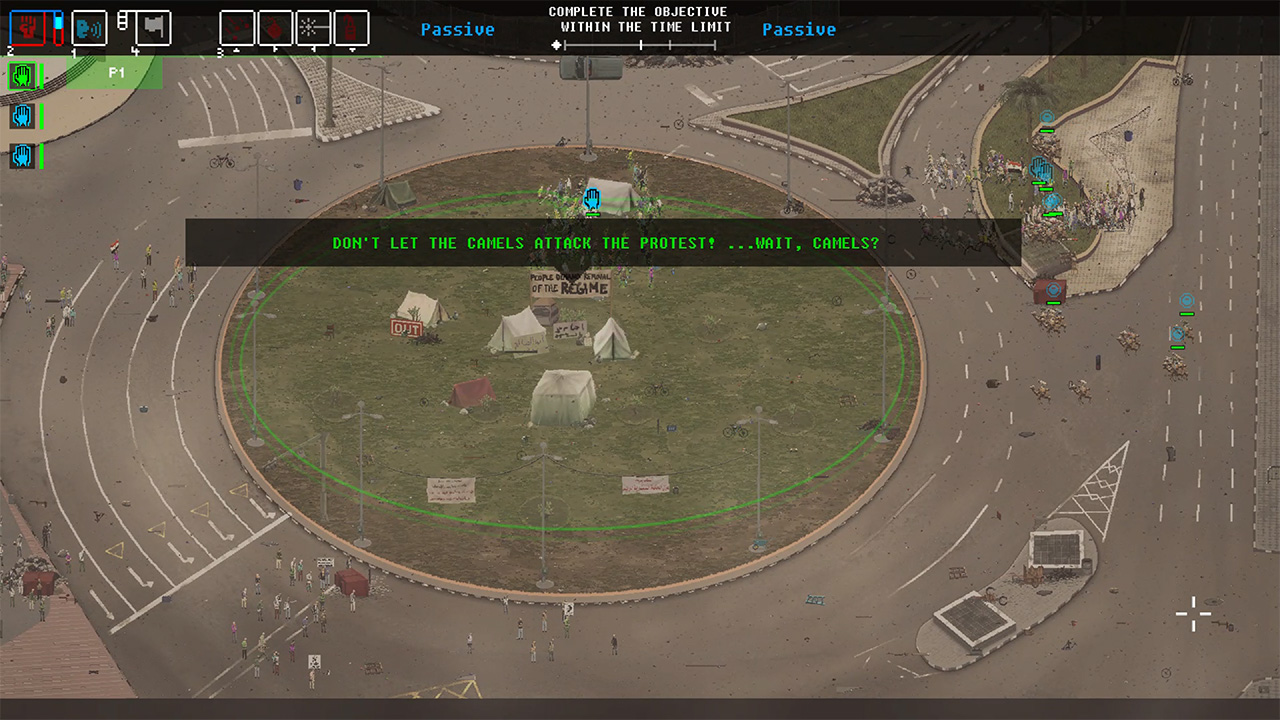
Eventually you do get a feeling for the mechanics of the game, and develop a bit of a rhythm, but at that point it starts to become apparent just how shallow and simplistic the system really is. Once you figure out a winning tactic for a level, watching the results unfold is surprisingly dull. A lot of encounters reach a tipping point, after which the struggle becomes suspenselessly one-sided. When this happens, there’s nothing to do but just sit there and wait for the timer to reach its inevitable conclusion so you can move on. There are almost no surprises, little tension, and a non-existent emotional pay-off for success or defeat. At times, RIOT feels more like a puzzle game where there is only a single answer. That approach would be fine if that’s what the player is expecting, but since it’s being marketed as a strategy game, this makes each match feel like a disappointment, even when you do win.
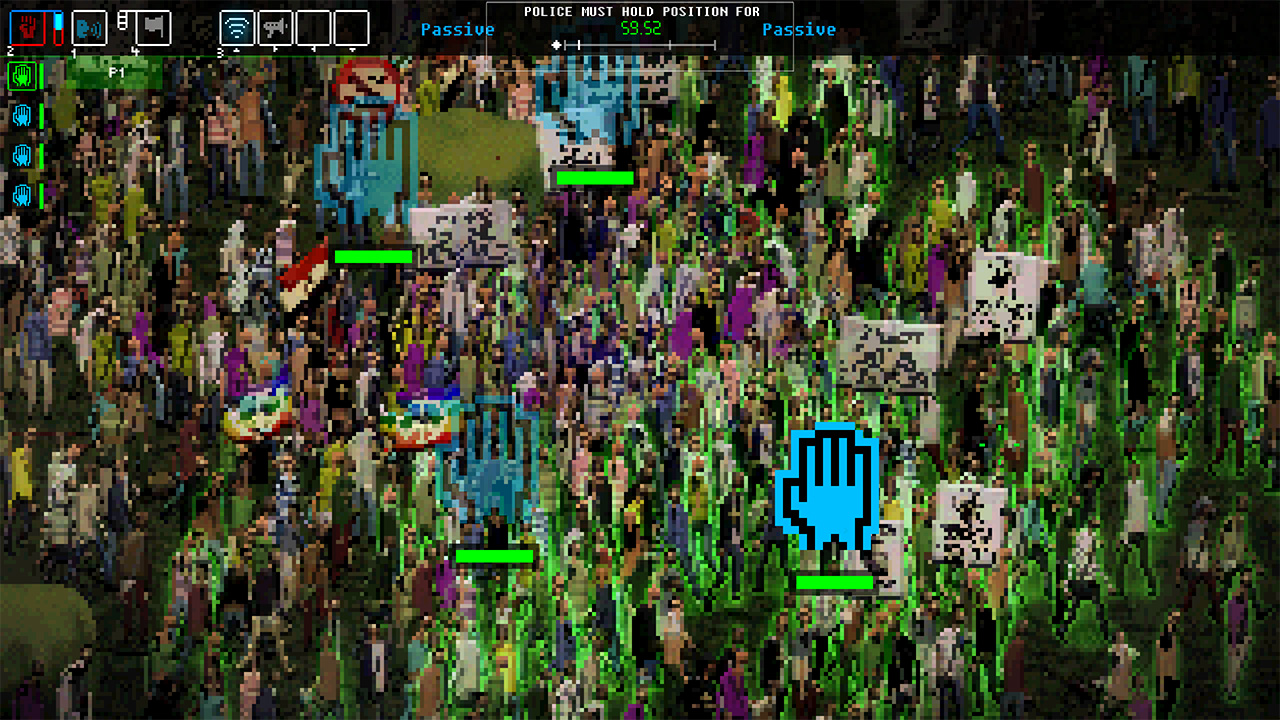
The softer side of civil unrest
However, there are other ways of playing RIOT that somewhat make up for this lack of depth. The main mode is Global play, where you move through clashes across the globe sequentially, using your victories to build up your team, add items, unlock new characters, and gain political clout as the levels progressively intensify. Or, you can take a more piecemeal approach with Story mode, where you can selectively choose which riots to engage in. Spectator mode basically pits the computer against itself, and lets you loosely define the stats of each side, allowing you to watch the results as the game simulates the battle to the best of its well-intentioned-ability (quick tip: if you find yourself continually stuck on a level, using Spectator mode is a nice way to study various outcomes before trying a tactic for yourself). There is also a local multiplayer mode, but I didn’t have a chance to test that one. Finally, there’s a Journalist mode, which is a pacifist way to engage in each battle; essentially you control a lone photographer who has to navigate around the clash and take photos, the more juicy the action, the more money you earn. Having these additional play options definitely adds more depth to the otherwise extremely limited main game.
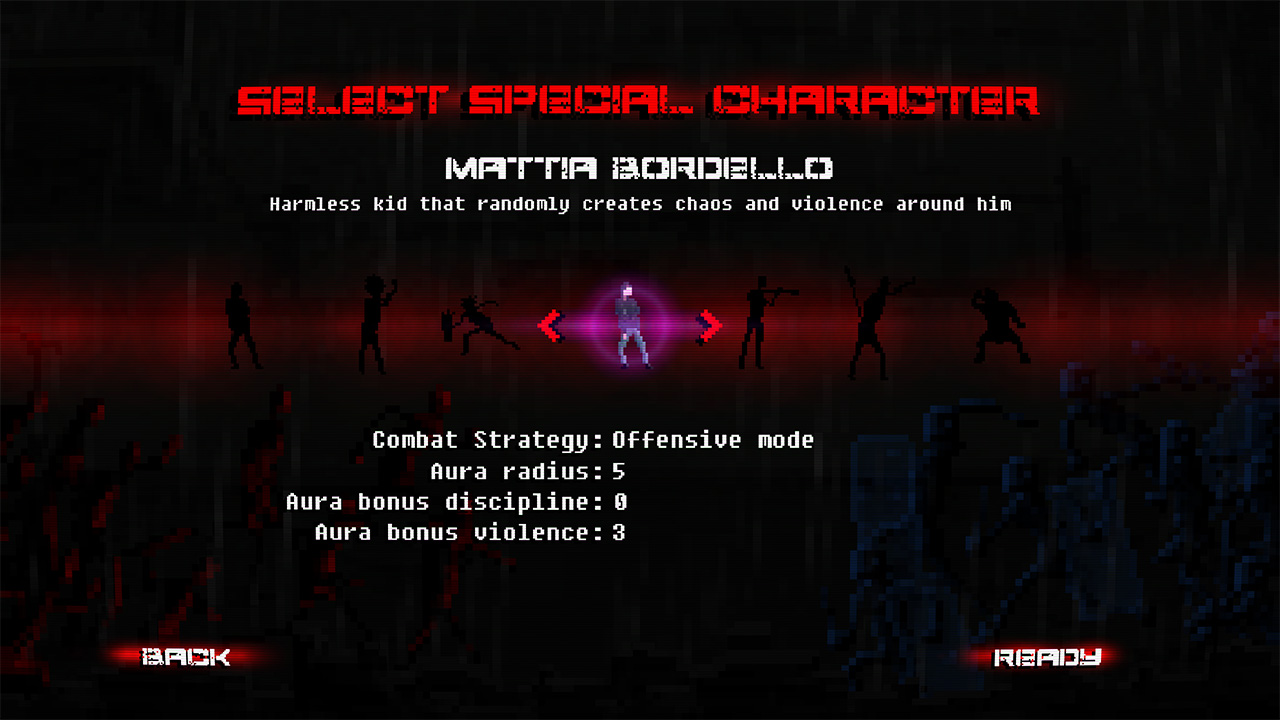
Maybe I’m just a nihilist, but based on the premise, I was hoping for a strategy game that really sunk its teeth into dangerous ideas, but instead, RIOT just sort of gnaws at its theme with a weak whimper. The developers have made a very simplistic and tepid portrayal of what is otherwise a very complex subject. I don’t fault them for this, but in being so even-handed, it completely neutralizes any tension, because there’s no meaning behind the actions; the stakes are there in principle, but the gameplay is just too abstracted to carry any weight. There is no personality beyond the animations to indicate that there’s any sense of passion about what the game is presenting. And given the subject matter, the game is far less controversial than its title would have you believe. On one hand, this broadens the marketability, but on the other hand it makes the resulting game feel a tad generic.
At no point did I feel truly in control of anything while playing RIOT, and finishing a level or overcoming a challenge was never satisfying. That’s my own personal experience, based on my own preconceived desire for a more nuanced game, perhaps. Taken on its own merits, the gameplay is innocuous at best, and unmemorable at worst. But a game can be more than the sum of its uneasy parts, and there are other aspects of RIOT that do, in fact, fair better.
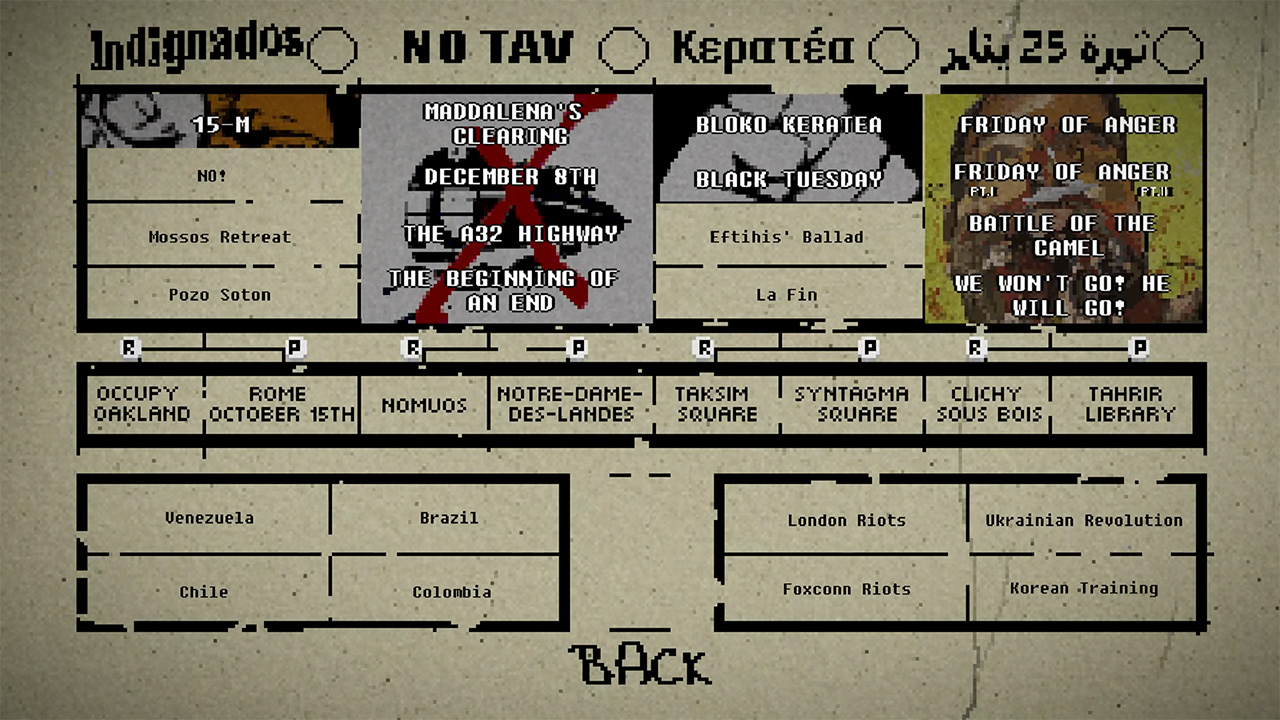
Messy, but a sight to behold
As I’ve already hinted at throughout this review, the artwork is fantastic. Barring how cluttered the sprites can get, the actual designs for the characters and gear are wonderful. The set pieces, despite not being wide enough, are nice and balance functionality with stylistic interpretation. The sound and music perfectly suit the mood and enthusiastically bring the game to life. The star, though, are the animations: each time you begin a new level, you are treated to beautifully animated cut-scenes that set the stage for the challenge ahead. These are gorgeously crafted and give RIOT a high degree of polish, and are one of the main motivations for continuing to play.
Audio-visual indulgences aside, RIOT is also a treat for your creativity. Where it falters in play, it makes up for in customization. Perhaps the single feature saving RIOT from total obscurity is its surprisingly fully-featured level editor. The editor lets you make your own maps, goals, obstacles, load-outs, victory conditions, and can be shared with others to experience. When creating a level, you can base it off an actual world event, and the devs have thoughtfully added slots for Wikipedia links to give players more factual information behind the event being simulated. This is very noble and ensures that there will never be a shortage of new levels, as there is never a shortage of global conflict.
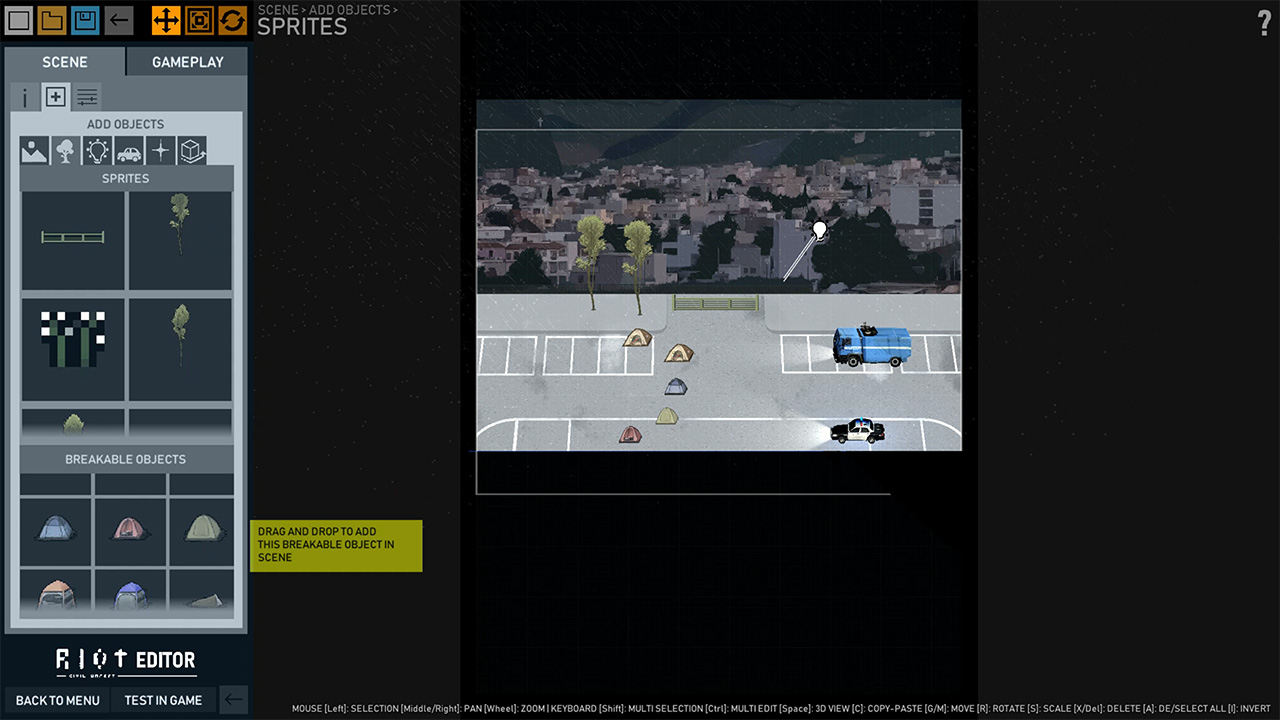
Verdict
I struggle with whether or not to recommend RIOT, because despite its flawed gameplay there are a lot of great features that could potentially be selling points. The artwork, animation, sound, and music are all amazing, the entire concept and subject matter are very unique and stand out in a crowded market, the amount of customization offered (including the level editor) is incredible, and the price is spot on. And yet…I have to be honest and say that I personally just did not enjoy my experience with the game. I very much wanted to buy into this title, and each time I launched it I kept hoping that it would surprise me and reverse my withering outlook. But each time I just felt more and more disappointed. The gameplay promised so much, delivered so little, and was ultimately a letdown for me.
If you’re looking for a unique and well-thought-out strategy game, keep moving; but if the idea of a riot sandbox catches your fancy, you might find more hours of joy crafting your own levels and watching the results than you do playing the actual game (phenomenal animations aside). It’s very clear that the developers have talent, and I do believe they’ve hit on a great idea, so hopefully future endeavors can build on the successful elements here. As for me, my rioting days are at an end; putting away the pepper spray, hanging the gas mask back in the closet, all I’m left with is this battle-scarred white flag, which now I humbly raise.

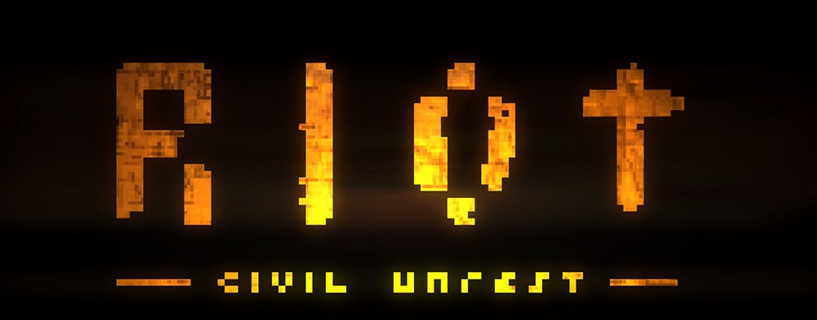









I played it at the start of its early access phase, and also found the game uninteresting to play despite its gorgeous graphics. I’m sad to see that it stayed the course.